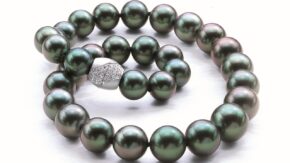It’s essential to know how to protect your business when entering into a credit memorandum.
Consignment memoranda are efficient business tools for merchants and suppliers in the diamond and high-end jewelry industry, but they are not without risk. A diamond or other valuable jewelry can end up in the wrong hands, and the credit memorandum won’t be worth the paper on which it’s written.
On a basic level, the credit memorandum, or memo, is an agreement between the supplier of the jewelry, and the merchant: If the jewelry or diamond sells, the merchant will pay the supplier, and if it doesn’t, it will be returned to the supplier and the memo will be destroyed.
The merchant must sign the memo to make it binding. Sounds simple, but if it is kept too simple, trouble may arise.
Get it certified
Before offering a piece of jewelry or a gemstone for consignment, merchants would be well advised to authenticate it. In the case of diamonds, that means the next stop is the Gemological Institute of America (GIA).
“GIA certification and tagging are integral measures to be taken to prevent fraud and to insure the safe return of diamonds and expensive jewelry in the event of theft,” says Dan Coleman, an associate at investigatory and security firm T&M Protection Resources in New York. GIA certification provides a precise description of the diamond so that if the merchant returns a fake, for instance, the fraud is easy to spot.
Additionally, notes Coleman, there are jewelry registries for suppliers, which make it easier to identify and recover stolen items.
Know your client
For a supplier, knowing your customer is of paramount importance to fraud prevention. These days, we can cull a lot of relevant information directly from the internet, but working with an investigatory service often proves to be more accurate.
“A background check, a credit check and social media review can often authenticate a business associate’s bona fides,” says Coleman. Another security risk he cites is organized crime. Such groups have traditionally targeted diamond dealers by tracking their daily routines and monitoring their security systems.
Unfortunately, they are also moving to white-collar crime tactics, using false identities to enter consignment agreements and steal the goods. “Hiring a security firm to perform a background check can prevent this type of fraud,” states Coleman. Additionally, suppliers can check credit reports with the Jewelers Board of Trade (JBT).
Prevention better than cure
Donna G. Recant, a former New York County Criminal Court judge who is now of counsel to Guzov, LLC, has unfortunately seen far too many credit memoranda gone awry. The prevalence of criminal and civil fraud cases in the jewelry industry is staggering, she reports.
“It is far too common for a supplier to provide a million-dollar diamond in exchange for a credit memo, only to find that the merchant returns a fake stone or a substituted stone worth far less than the original (frequently referred to as a ‘bait and switch’),” says Recant. “Without any way to prove the authenticity of the diamond provided to the merchant, the supplier’s avenues for recourse will be severely limited.”
In the civil arena, damage to jewelry on consignment is also quite common, making it absolutely necessary to photograph inventory before turning it over, she adds. She is a strong proponent of jewelry registries, certifications, and tagging to prevent fraud, along with detailed, signed receipts. If all else fails, “make sure you are fully insured,” she advises.
Insurance companies provide options such as jewelers’ block policies, which cover the risks that accompany consignment.
5 Tips for Memo Security
Seeking independent legal advice and meticulously drafting a memo will significantly deter fraud and other security risks.
Here are some additional precautionary steps that Dan Coleman of T&M Protection Resources recommends:
1. Do your due diligence! Hire an investigation firm that can do thorough background and credit checks.
2. At a minimum, ask for – and check – references.
3. Trust your gut. If it’s too good to be true, it probably is.
4. Have your diamond inventory GIA-certified.
5. Avail yourself of jewelry registries to increase the chances of recovery in the event of theft.
Looking ahead: blockchain
As financial technology advances, consignment memoranda will eventually involve the use of blockchain technology and smart contracts. The technology can be engineered to authenticate diamonds and gemstones, as well as secure a cryptocurrency payment from the merchant.
Blockchain can transform the memo process by creating a more transparent, secure and efficient system that can limit fraud and security risks.
Debra J. Guzov, Esq., is the founder of New York law fi rm Guzov, LLC, specializing in corporate transactions and litigation. She frequently advises clients in the jewelry industry. Harley Auerbach is a paralegal at the company.
Image: Shutterstock




